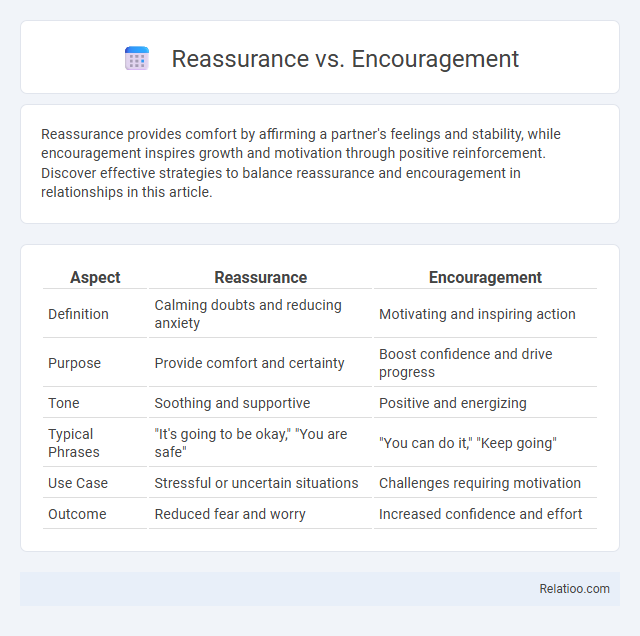Reassurance provides comfort by affirming a partner's feelings and stability, while encouragement inspires growth and motivation through positive reinforcement. Discover effective strategies to balance reassurance and encouragement in relationships in this article.
Table of Comparison
| Aspect | Reassurance | Encouragement |
|---|---|---|
| Definition | Calming doubts and reducing anxiety | Motivating and inspiring action |
| Purpose | Provide comfort and certainty | Boost confidence and drive progress |
| Tone | Soothing and supportive | Positive and energizing |
| Typical Phrases | "It's going to be okay," "You are safe" | "You can do it," "Keep going" |
| Use Case | Stressful or uncertain situations | Challenges requiring motivation |
| Outcome | Reduced fear and worry | Increased confidence and effort |
Understanding Reassurance: Definition and Purpose
Reassurance is the act of providing comfort and confidence to alleviate doubts or fears, often through affirming statements or supportive actions. Its primary purpose is to reduce anxiety by reinforcing a sense of safety and trust, helping individuals feel secure in uncertain situations. Understanding reassurance involves recognizing its role in emotional regulation and stress management, distinguishing it from encouragement, which motivates action, and support, which offers ongoing assistance.
The Essence of Encouragement: What It Really Means
Encouragement is the act of inspiring confidence and motivation in someone by highlighting their strengths and potential. You experience true encouragement when someone acknowledges your efforts and provides positive reinforcement that fuels your determination to overcome challenges. Unlike reassurance, which aims to comfort by reducing doubt or fear, encouragement actively promotes growth and resilience through uplifting communication.
Psychological Impact: How Reassurance and Encouragement Differ
Reassurance primarily reduces anxiety by confirming safety and stability, thereby calming emotional distress and providing comfort. Encouragement stimulates motivation and confidence by promoting positive beliefs about one's abilities and future outcomes, fostering proactive behavior and resilience. While reassurance addresses immediate emotional security, encouragement drives long-term psychological growth and goal-oriented persistence.
When to Offer Reassurance vs When to Provide Encouragement
Offering reassurance is essential when someone feels anxious or uncertain, as it calms fears by confirming stability and support. Providing encouragement is most effective when Your goal is to motivate action, build confidence, or inspire growth during challenges or new endeavors. Recognizing the emotional state and situational needs helps determine whether reassurance or encouragement will best support positive outcomes.
Common Mistakes in Reassuring and Encouraging Others
Common mistakes in reassuring others include offering empty platitudes that ignore genuine feelings, which can undermine trust and emotional support. Encouragement often falters when it becomes overly directive or pressure-filled, leading to increased anxiety rather than motivation. Confusing reassurance with encouragement can cause mixed messages, where individuals feel both questioned and patronized instead of genuinely supported.
Language Matters: Words That Reassure vs Words That Encourage
Words that reassure focus on reducing anxiety and providing comfort by affirming stability and safety, while words that encourage inspire action and boost motivation by highlighting potential and progress. Understanding the subtle differences in language helps tailor communication to your audience's emotional needs, whether calming fears or promoting confidence. Your choice of words can significantly impact how support is perceived and the effectiveness of your message.
Reassurance in Crisis: Providing Stability and Calm
Reassurance in crisis offers crucial stability and calm by addressing immediate fears and uncertainties, helping individuals regain a sense of control. Your ability to provide consistent, empathetic support reinforces trust and reduces anxiety, fostering resilience during turbulent times. Unlike encouragement, which motivates future action, reassurance centers on soothing present distress and affirming safety.
Encouragement for Growth: Fostering Confidence and Action
Encouragement for growth plays a crucial role in fostering confidence and motivating action by affirming your abilities and potential. Unlike reassurance, which aims to alleviate doubt, encouragement actively inspires you to embrace challenges and pursue progress with resilience. This proactive support cultivates a growth mindset, enabling continuous personal and professional development.
Balancing Both: Integrating Reassurance and Encouragement Effectively
Balancing reassurance and encouragement requires understanding their distinct yet complementary roles in motivation and confidence-building. Reassurance provides a sense of security and reduces anxiety by affirming safety and competence, while encouragement fuels persistence and resilience through positive reinforcement and goal-oriented feedback. Effectively integrating both involves tailoring responses to individual needs, offering reassurance during moments of doubt and boosting motivation with encouragement to sustain effort and growth.
Practical Tips: Enhancing Your Support Skills
Reassurance involves affirming someone's feelings to reduce anxiety and build trust, while encouragement focuses on motivating action and fostering confidence toward goals. Practical tips for enhancing support skills include active listening, using empathetic language, recognizing achievements, and tailoring your approach to individual needs. Combining reassurance and encouragement strategically helps create a balanced support system that nurtures emotional security and promotes growth.

Infographic: Reassurance vs Encouragement
 relatioo.com
relatioo.com